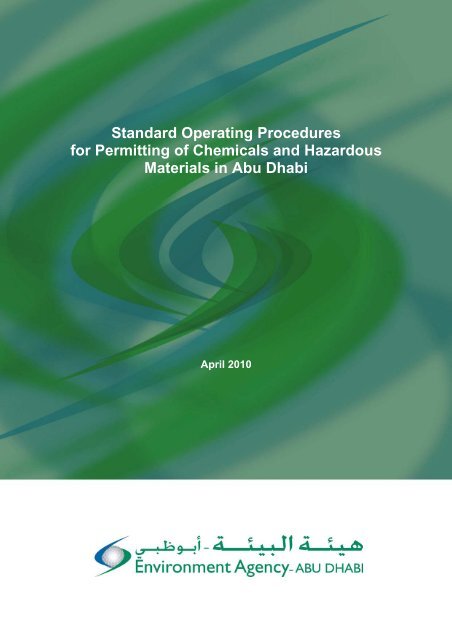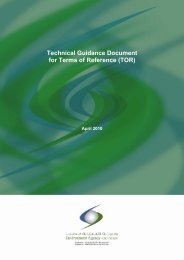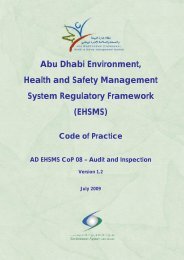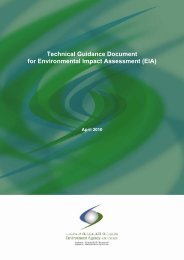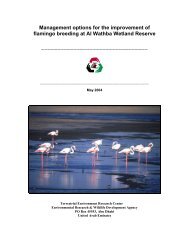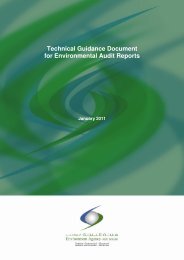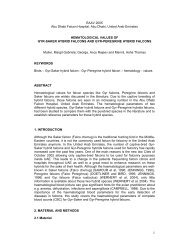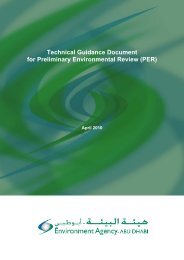Standard Operating Procedures for Permitting of Chemicals and ...
Standard Operating Procedures for Permitting of Chemicals and ...
Standard Operating Procedures for Permitting of Chemicals and ...
You also want an ePaper? Increase the reach of your titles
YUMPU automatically turns print PDFs into web optimized ePapers that Google loves.
<strong>St<strong>and</strong>ard</strong> <strong>Operating</strong> <strong>Procedures</strong><br />
<strong>for</strong> <strong>Permitting</strong> <strong>of</strong> <strong>Chemicals</strong> <strong>and</strong> Hazardous<br />
Materials in Abu Dhabi<br />
April 2010
<strong>St<strong>and</strong>ard</strong> <strong>Operating</strong> <strong>Procedures</strong> <strong>for</strong> <strong>Permitting</strong> <strong>of</strong> <strong>Chemicals</strong> <strong>and</strong> Hazardous Materials in Abu Dhabi<br />
Table <strong>of</strong> Contents<br />
List <strong>of</strong> Abbreviations ............................................................................................................................ iii<br />
Definition <strong>of</strong> Terms ................................................................................................................................ iv<br />
1. Introduction ...................................................................................................................................... 1<br />
1.1 What Is an Environmental Permit <strong>for</strong> Trading in <strong>Chemicals</strong> <strong>and</strong> Hazardous<br />
Materials? ............................................................................................................................... 1<br />
1.2 Why Is It Required? ................................................................................................................ 1<br />
1.3 What Facilities Are Subject to Chemical <strong>and</strong> Hazardous Materials <strong>Permitting</strong>? ................... 1<br />
1.4 How Do I Obtain a Permit <strong>for</strong> Trading in <strong>Chemicals</strong> <strong>and</strong> Hazardous Materials? .................. 4<br />
1.5 How Do I Renew My Permit? ................................................................................................ 4<br />
2. Environmental <strong>Permitting</strong> Process <strong>for</strong> <strong>Chemicals</strong> <strong>and</strong> Hazardous Materials ................................... 4<br />
2.1 Submitting a Permit Application ............................................................................................ 4<br />
Application ............................................................................................................................. 4<br />
Review <strong>and</strong> Approval ............................................................................................................. 6<br />
2.2 Renewing a Permit Application .............................................................................................. 6<br />
Application ............................................................................................................................. 6<br />
Review <strong>and</strong> Approval ............................................................................................................. 7<br />
2.3 Communications with EAD .................................................................................................... 8<br />
3. Permit Conditions ............................................................................................................................. 8<br />
3.1 Import <strong>and</strong> Export ................................................................................................................... 8<br />
3.2 Production ............................................................................................................................... 9<br />
3.3 Distribution ........................................................................................................................... 10<br />
3.4 Advertisement ....................................................................................................................... 10<br />
Annex 1 Application <strong>for</strong> Trading in <strong>Chemicals</strong> <strong>and</strong> Hazardous Materials .......................................... 11<br />
Annex 2 List <strong>of</strong> <strong>Chemicals</strong> <strong>and</strong> Hazardous Materials Banned <strong>and</strong> Restricted in UAE ....................... 12<br />
List <strong>of</strong> Figures<br />
1. The process <strong>for</strong> obtaining a permit <strong>for</strong> trading in chemicals <strong>and</strong> hazardous materials. ............. 5<br />
2. The process <strong>for</strong> renewing a permit <strong>for</strong> trading in chemicals <strong>and</strong> hazardous materials. ............. 7<br />
List <strong>of</strong> Tables<br />
1. UN Classes <strong>and</strong> Subclasses <strong>of</strong> Hazardous Materials ................................................................. 3<br />
ii
<strong>St<strong>and</strong>ard</strong> <strong>Operating</strong> <strong>Procedures</strong> <strong>for</strong> <strong>Permitting</strong> <strong>of</strong> <strong>Chemicals</strong> <strong>and</strong> Hazardous Materials in Abu Dhabi<br />
List <strong>of</strong> Abbreviations<br />
AD EHS Center<br />
CAS No. or CAS RN<br />
EAD<br />
EHSMS<br />
MSDS<br />
SOP<br />
SRA<br />
UN No.<br />
Abu Dhabi Environment, Health, <strong>and</strong> Safety Center<br />
Chemical Abstract Service Number<br />
Environment Agency–Abu Dhabi<br />
Environment, Health <strong>and</strong> Safety Management System<br />
Material Safety Data Sheet<br />
<strong>St<strong>and</strong>ard</strong> <strong>Operating</strong> Procedure<br />
Sector Regulatory Authority<br />
United Nations Number<br />
iii
<strong>St<strong>and</strong>ard</strong> <strong>Operating</strong> <strong>Procedures</strong> <strong>for</strong> <strong>Permitting</strong> <strong>of</strong> <strong>Chemicals</strong> <strong>and</strong> Hazardous Materials in Abu Dhabi<br />
Definition <strong>of</strong> Terms<br />
Auto-ignition Temperature—The minimum temperature required to initiate or cause self-sustained<br />
combustion in any substance in the absence <strong>of</strong> a spark or flame.<br />
Adverse—An abnormal, undesirable, or harmful change.<br />
Carcinogens—Any chemical or substance that is capable <strong>of</strong> causing or inducing cancer.<br />
Chemical—Any element, compound, or mixture <strong>of</strong> elements <strong>and</strong>/or compounds. A substance that<br />
possesses hazardous properties including but not limited to flammability, toxicity, corrosivity, or<br />
reactivity.<br />
Chemical Abstract Service Number (CAS No. or CAS RN)—An internationally recognized<br />
registration number assigned by the Chemical Abstract Service to uniquely describe either a chemical,<br />
a group <strong>of</strong> similar chemicals, or a mixture. The CAS Number (sometimes described as a Registry<br />
Number or RN) consists <strong>of</strong> up to nine digits <strong>and</strong> provides an accurate way <strong>of</strong> retrieving a substance<br />
from a computer database. The CAS Number is simply a reference number, <strong>and</strong> unlike the UN<br />
Number, cannot be linked to any particular chemical or physical properties.<br />
Chemical Product—A mixture <strong>of</strong> any combination <strong>of</strong> two or more chemicals that may or may not be<br />
the result, in whole or in part, <strong>of</strong> a chemical reaction, which itself has hazardous properties.<br />
Compatible—Two or more substances or items that will not react together to cause fire, explosion,<br />
harmful reaction, or the evolution <strong>of</strong> flammable, toxic, or corrosive vapours.<br />
Competent Authority—The local environmental authority.<br />
Corrosive (Class 8)—Any liquid or solid that causes full-thickness destruction <strong>of</strong> human skin tissue<br />
at the site <strong>of</strong> contact, within a specified period <strong>of</strong> time. Acids <strong>and</strong> Bases are common corrosives.<br />
Explosives—Any substance, article, or device that is designed to function by explosion (i.e., an<br />
extremely rapid release <strong>of</strong> gas <strong>and</strong> heat) or by which a chemical reaction occurs within itself or is able<br />
to function in a similar manner even if not designed to function by explosion. A variety <strong>of</strong> terms are<br />
used when determining the chemical stability <strong>of</strong> a material to ignite or explode. These are lower<br />
explosive limit, upper explosive limit, flash point, flammable range, <strong>and</strong> auto-ignition temperature.<br />
Flash Point—The minimum temperature at which a liquid gives <strong>of</strong>f vapour in sufficient<br />
concentration to <strong>for</strong>m an ignitable mixture with air near the surface <strong>of</strong> the liquid.<br />
Flammable/Inflammable Liquids—Liquids, mixtures <strong>of</strong> liquids, or liquids containing solids in<br />
solution or suspension (e.g., paints, varnishes, etc.) that have a flash point <strong>of</strong> 60.5 °C (141°F) or<br />
lower.<br />
Flammable Range—The difference between the lower <strong>and</strong> upper flammable limits, expressed in<br />
terms <strong>of</strong> percentage <strong>of</strong> vapour or gas in air by volume. It is also sometimes referred to as the<br />
“exchange rate.”<br />
Flammable Solids—Solids or waste solids, other than those classed as explosives that are readily<br />
combustible, or may cause or contribute to fire through friction, under conditions encountered in<br />
transport.<br />
H<strong>and</strong>ling—Conveying, manufacturing, processing, using, treating, dispensing, packing, selling,<br />
transporting, or disposing <strong>of</strong> a chemical or hazardous material.<br />
iv
<strong>St<strong>and</strong>ard</strong> <strong>Operating</strong> <strong>Procedures</strong> <strong>for</strong> <strong>Permitting</strong> <strong>of</strong> <strong>Chemicals</strong> <strong>and</strong> Hazardous Materials in Abu Dhabi<br />
Hazard—A source <strong>of</strong> danger (i.e., material, energy source, or operation) with the potential to cause<br />
illness, injury, or death to personnel or damage to a facility or to the environment.<br />
Hazardous Material—A substance with potential to cause harm to persons, property, or the<br />
environment due to one or more <strong>of</strong> the following:<br />
• Chemical properties <strong>of</strong> the substance;<br />
• Physical properties <strong>of</strong> the substance; or<br />
• Biological properties <strong>of</strong> the substance.<br />
Hazardous Substance—A substance that has the potential to harm the health or safety <strong>of</strong> persons in<br />
the workplace, including substances that may be produced in the workplace.<br />
Importer—Any individual or company in Abu Dhabi Emirate who arranges with a <strong>for</strong>eign company<br />
or an overseas agent to provide chemical <strong>and</strong> hazardous materials to the Emirate.<br />
Infectious Substance (Division 6.2)—“A viable microorganism, or its toxin, which causes or may<br />
cause disease in humans or animals, or any other agent that causes or may cause severe, disabling, or<br />
fatal disease.” The terms infectious substance <strong>and</strong> etiologic agent are synonymous. Examples include<br />
biological cultures <strong>and</strong> medical waste.<br />
Irritants—<strong>Chemicals</strong> that can inflame the eyes, skin, or respiratory system (e.g., ammonia).<br />
Label—A printed hazard warning notice that identifies the primary <strong>and</strong> secondary hazards specific to<br />
a material <strong>and</strong> contains h<strong>and</strong>ling in<strong>for</strong>mation. Labels must be at least be 100 mm × 100 mm unless<br />
otherwise specified.<br />
Material Safety Data Sheet—A document which contains in<strong>for</strong>mation on the material, manufacturer,<br />
potential chemical hazards, first aid advice, precautions <strong>for</strong> use, <strong>and</strong> safe h<strong>and</strong>ling in<strong>for</strong>mation (see<br />
“Attachment 3 <strong>of</strong> Code <strong>of</strong> Practice <strong>and</strong> <strong>Permitting</strong> <strong>Procedures</strong>, Environmental Services Providers” <strong>for</strong><br />
sample MSDS).<br />
Package—The complete product <strong>of</strong> the packing <strong>of</strong> chemicals <strong>and</strong> hazardous materials <strong>for</strong> transport,<br />
which consists <strong>of</strong> materials <strong>and</strong> their packaging.<br />
Packaging—The container in which materials or goods are received or held <strong>for</strong> transport, including<br />
anything that enables the container to receive or hold the material or goods.<br />
Oxidizers—Substances or wastes that in themselves are not necessarily combustible but may yield<br />
oxygen, causing or contributing to the combustion <strong>of</strong> other materials.<br />
Organic Peroxides—Any organic substance or waste that contains oxygen (O) in the bivalent<br />
__O__O__ structure, which may be considered a derivative <strong>of</strong> hydrogen peroxide, where one or more<br />
<strong>of</strong> the hydrogen atoms have been replaced by organic radicals.<br />
Risk—The quantitative or qualitative expression <strong>of</strong> possible loss that considers both the probability<br />
that a hazard will cause harm <strong>and</strong> the consequences <strong>of</strong> that event.<br />
Safety—Often referred as the opposite <strong>of</strong> risk. It is the practical certainty that adverse effects will not<br />
result when a substance is used in the quantity <strong>and</strong> in the manner proposed <strong>for</strong> its use.<br />
Safety case – A plan that details the prevention measures <strong>for</strong> all high-risk activities, substances,<br />
processes, <strong>and</strong> materials within the facility <strong>and</strong> also the emergency-response plans <strong>for</strong> the said<br />
activities.<br />
v
<strong>St<strong>and</strong>ard</strong> <strong>Operating</strong> <strong>Procedures</strong> <strong>for</strong> <strong>Permitting</strong> <strong>of</strong> <strong>Chemicals</strong> <strong>and</strong> Hazardous Materials in Abu Dhabi<br />
Toxicity—A physiological or biological property that determines the capacity <strong>of</strong> a chemical to do<br />
harm or injury to a living organism by other than mechanical means.<br />
United Nations Number—The identification serial number assigned to any chemical or hazardous<br />
material by the United Nations (UN) Committee <strong>of</strong> Experts on the transportation <strong>of</strong> these materials<br />
<strong>and</strong> as published in the UN recommendations on the transport <strong>of</strong> dangerous goods.<br />
Waste—Any material or by-product that is discarded by being ab<strong>and</strong>oned (i.e., disposed <strong>of</strong>, burned,<br />
incinerated, recycled), or considered inherently waste-like.<br />
vi
<strong>St<strong>and</strong>ard</strong> <strong>Operating</strong> <strong>Procedures</strong> <strong>for</strong> <strong>Permitting</strong> <strong>of</strong> <strong>Chemicals</strong> <strong>and</strong> Hazardous Materials in Abu Dhabi<br />
1. Introduction<br />
The Environment Agency–Abu Dhabi’s (EAD’s) establishes st<strong>and</strong>ards <strong>of</strong> conduct <strong>for</strong> all public <strong>and</strong><br />
private entities <strong>for</strong> the promotion <strong>of</strong> environmentally sound management practices <strong>for</strong> chemicals <strong>and</strong><br />
hazardous materials in Abu Dhabi Emirate. The code is developed in line with the Federal Law No.<br />
24 <strong>and</strong> its bylaws regarding the management <strong>of</strong> chemicals <strong>and</strong> hazardous materials.<br />
These st<strong>and</strong>ard operating procedures (SOPs) clearly define the roles <strong>of</strong> the proponent <strong>and</strong> EAD in<br />
order to put in place practices that will minimize potential health <strong>and</strong> environmental risks associated<br />
with the h<strong>and</strong>ling <strong>of</strong> chemicals <strong>and</strong> hazardous materials.<br />
These SOPs are intended to support the requirements <strong>of</strong> Abu Dhabi Emirate Environment, Health <strong>and</strong><br />
Safety Management System (EHSMS) Regulatory Framework (Decree 42 <strong>of</strong> 2009). The proponent<br />
must comply with any additional requirements <strong>for</strong> the import, export, h<strong>and</strong>ling, storage, <strong>and</strong> use <strong>of</strong><br />
chemicals or hazardous materials within the EHSMS Regulatory Framework (without exception).<br />
Failure to comply with these conditions will result in the environmental permit being revoked.<br />
Furthermore, EAD is developing an integrated system <strong>for</strong> hazardous materials management that<br />
contains a distribution module that will allow hazardous materials storage <strong>and</strong> industrial facilities to<br />
record <strong>and</strong> track quantities <strong>of</strong> materials they store, distribute, <strong>and</strong> use, <strong>and</strong> to maintain an inventory <strong>of</strong><br />
their stocks.<br />
1.1 What Is an Environmental Permit <strong>for</strong> Trading in <strong>Chemicals</strong> <strong>and</strong> Hazardous<br />
Materials?<br />
Environmental permits are issued by an environmental agency to facilities that import, export,<br />
produce, store or manage chemicals or hazardous materials to ensure that necessary measures to<br />
minimize adverse effects on the environment are maintained. The permit must be renewed annually to<br />
ensure compliance with its conditions <strong>and</strong> to update the permit to reflect current operations at the<br />
facility.<br />
1.2 Why Is It Required?<br />
Federal Environmental Law 24/1999 <strong>and</strong> its bylaws require that all projects or establishments obtain a<br />
license prior to starting the activity. In order to receive this license, the facility owner (proponent)<br />
must assess the environmental impacts <strong>of</strong> the activities.<br />
The permitting <strong>of</strong> chemical <strong>and</strong> hazardous materials facilities supports the requirements <strong>of</strong> the Abu<br />
Dhabi Emirate EHSMS Regulatory Framework (Decree 42 <strong>of</strong> 2009).<br />
Furthermore, facilities that are nominated under the EHSMS Regulatory Framework <strong>and</strong> are required<br />
to apply <strong>for</strong> an environmental permit will automatically be required to develop a safety case. The<br />
requirements <strong>for</strong> developing a safety case are outlined within COP 05 <strong>of</strong> the EHSMS.<br />
The developed safety case will be monitored by the Sector Regulatory Authority (SRA; the SRAs are<br />
responsible <strong>for</strong> implementing EHSMS Regulatory Framework in each Emirate sector), in conjunction<br />
with EAD <strong>and</strong> the Abu Dhabi Environment, Health, <strong>and</strong> Safety Center (AD EHS Center; i.e., the<br />
Competent Authority <strong>for</strong> the EHSMS Regulatory Framework). EAD reserves the right to undertake<br />
audits <strong>and</strong> inspections on the facility over <strong>and</strong> above those <strong>of</strong> the SRA.<br />
1.3 What Facilities Are Subject to Chemical <strong>and</strong> Hazardous Materials <strong>Permitting</strong>?<br />
The proponent <strong>of</strong> a new facility that intends to primarily deal with chemicals or hazardous materials<br />
(e.g., import, export, produce or distribute) should apply <strong>for</strong> a Trading in <strong>Chemicals</strong> <strong>and</strong> Hazardous<br />
Materials permit through EAD <strong>and</strong> comply with the conditions related to this activity as set <strong>for</strong>th by<br />
EAD. An application <strong>for</strong> a Technical Modification must be submitted to EAD <strong>for</strong> any modification at<br />
1
<strong>St<strong>and</strong>ard</strong> <strong>Operating</strong> <strong>Procedures</strong> <strong>for</strong> <strong>Permitting</strong> <strong>of</strong> <strong>Chemicals</strong> <strong>and</strong> Hazardous Materials in Abu Dhabi<br />
an existing permitted facility, including the addition <strong>of</strong> new chemicals or hazardous materials <strong>and</strong><br />
process changes. Permits must be renewed annually.<br />
Based on the UN classification system (UN, 1998) there are nine major hazard classes as shown in<br />
Table 1 below.<br />
Facilities/companies dealing with chemicals <strong>and</strong> hazardous materials in other ways (e.g., industrial<br />
facilities <strong>and</strong> waste treatment facilities) will also have to be permitted by EAD. However, permitting<br />
procedures <strong>for</strong> most <strong>of</strong> these facilities <strong>and</strong> the relevant conditions <strong>and</strong> codes <strong>of</strong> practice are contained<br />
in other EAD documents.<br />
2
<strong>St<strong>and</strong>ard</strong> <strong>Operating</strong> <strong>Procedures</strong> <strong>for</strong> <strong>Permitting</strong> <strong>of</strong> <strong>Chemicals</strong> <strong>and</strong> Hazardous Materials in Abu Dhabi<br />
UN<br />
Class<br />
1 Explosives<br />
Table 1. UN Classes <strong>and</strong> Subclasses <strong>of</strong> Hazardous Materials<br />
UN Classes <strong>and</strong> Subclasses <strong>of</strong> Hazardous Materials<br />
1.1 Explosives that have a mass explosion hazard. A mass explosion is one that affects almost the<br />
entire load instantaneously. Examples include ammonium perchlorate, barium styphnate, <strong>and</strong><br />
trinitronaphthalene.<br />
1.2 Explosives that have a projection hazard but not a mass explosion hazard. Examples include<br />
smoke ammunition, tear-producing ammunition, <strong>and</strong> toxic ammunition.<br />
1.3 Explosives that have a fire hazard <strong>and</strong> either a minor blast hazard or a minor projection hazard or<br />
both, but not a mass explosion hazard. Examples include deflagrating metal salts <strong>of</strong> aromatic nitro<br />
derivatives, toxic ammunition, practice ammunition, <strong>and</strong> smoke ammunition.<br />
1.4 Explosives that present a minor explosion hazard. The explosive effects are largely confined to the<br />
package <strong>and</strong> no projection <strong>of</strong> fragments <strong>of</strong> appreciable size or range is to be expected. Examples<br />
include nonelectric detonator assemblies <strong>for</strong> blasting, electric detonators <strong>for</strong> blasting, detonators <strong>for</strong><br />
ammunition, practice ammunition, cartridges <strong>for</strong> weapons, safety fuses, <strong>and</strong> fuse lighters.<br />
1.5 Very insensitive explosives. These are substances that have a mass explosion hazard but are so<br />
insensitive that there is little probability <strong>of</strong> initiation or <strong>of</strong> transition from burning to detonation under<br />
normal conditions <strong>of</strong> transport. Examples include blasting explosives <strong>and</strong> other very insensitive<br />
explosive substances.<br />
1.6 Extremely insensitive articles that do not have a mass explosion hazard. These are substances<br />
that contain only extremely insensitive detonating substances <strong>and</strong> demonstrate a negligible<br />
probability <strong>of</strong> accidental initiation or propagation.<br />
2 Gases<br />
2.1 Flammable gases (e.g., propane, butane, ethyl fluoride, <strong>and</strong> anhydrous trimethyamine).<br />
2.2 Non-flammable, nonpoisonous compressed gases (e.g., compressed oxygen, carbon dioxide,<br />
compressed nitrogen, <strong>and</strong> nitrogen trifluoride).<br />
2.3 Poisonous gas (by inhalation). Presumed to be poisonous because they have an LD50 value equal<br />
to or less than 5,000 ppm.<br />
3 Flammable Liquids<br />
Liquids, mixtures <strong>of</strong> liquids, or liquids containing solids in solution or in suspension (e.g., paints,<br />
varnishes, lacquers) that give <strong>of</strong>f a flammable vapor at temperatures <strong>of</strong> not more than 61ºC.<br />
4 Flammable Solids<br />
4.1 Flammable solids (e.g., gelatin-coated, nitrocellulose-based films <strong>and</strong> trinitrotoluene).<br />
4.2 Spontaneously combustible materials (e.g., pyrophoric titanium trichloride, sodium hydrosulfite).<br />
4.3 Dangerous when wet (e.g., lithium hydride, magnesium powder, alkaline earth metal alloys, <strong>and</strong><br />
amalgams).<br />
5 Oxidizers <strong>and</strong> Organic Peroxides<br />
5.1 Oxidizers (e.g., calcium permanganate, sodium chlorite, <strong>and</strong> lead perchlorate).<br />
5.2 Organic peroxides (e.g., methyl ethyl ketone peroxides (types B, C, <strong>and</strong> D), liquid, <strong>and</strong> dicetyl<br />
peroxide (type D), liquid, temperature controlled).<br />
6 Toxic Materials <strong>and</strong> Infectious Substances<br />
6.1 Toxic substances (e.g., liquid triazine pesticides, thioglycal, thallium nitrate, <strong>and</strong> carbon<br />
tetrachloride).<br />
6.2 Infectious substances (e.g., biological cultures <strong>and</strong> medical wastes).<br />
7 Radioactive Material<br />
Examples <strong>of</strong> this class include cobalt, gallium, plutonium, <strong>and</strong> other radio nuclides.<br />
8 Corrosive Materials<br />
Examples <strong>of</strong> this class include zinc chloride, sodium hydrogen fluoride solution, <strong>and</strong> calcium oxide.<br />
9 Miscellaneous Hazardous Material<br />
Examples <strong>of</strong> this class include plastic molding material in dough, sheet, or rope <strong>for</strong>m; exp<strong>and</strong>able<br />
polystyrene bead; <strong>and</strong> evolving flammable vapor.<br />
3
<strong>St<strong>and</strong>ard</strong> <strong>Operating</strong> <strong>Procedures</strong> <strong>for</strong> <strong>Permitting</strong> <strong>of</strong> <strong>Chemicals</strong> <strong>and</strong> Hazardous Materials in Abu Dhabi<br />
1.4 How Do I Obtain a Permit <strong>for</strong> Trading in <strong>Chemicals</strong> <strong>and</strong> Hazardous Materials?<br />
You must complete an Application <strong>for</strong> Trading in <strong>Chemicals</strong> <strong>and</strong> Hazardous Materials. EAD will<br />
thoroughly review the application <strong>and</strong>, if approved, will issue a permit valid <strong>for</strong> one year to the<br />
applicant. This process is detailed in Section 2.<br />
To help identify the types <strong>of</strong> in<strong>for</strong>mation you will need to complete the permit application, a sample<br />
permit application <strong>for</strong>m is provided in Annex 1.<br />
1.5 How Do I Renew My Permit?<br />
An inspection will be per<strong>for</strong>med by EAD 60 days prior to the expiration <strong>of</strong> your permit. After<br />
completing any corrective actions outlines in the inspection report, you must submit an application<br />
<strong>for</strong>m <strong>and</strong> required documentation within 30 days <strong>of</strong> your permit’s expiration. This process is outlined<br />
in Section 3.<br />
2. Environmental <strong>Permitting</strong> Process <strong>for</strong> <strong>Chemicals</strong> <strong>and</strong><br />
Hazardous Materials<br />
This section provides step-by-step instructions <strong>for</strong> obtaining <strong>and</strong> renewing a permit <strong>for</strong> importers,<br />
exporters, producers <strong>and</strong> distributors <strong>of</strong> chemicals <strong>and</strong> hazardous materials.<br />
For both new permit applications <strong>and</strong> renewals, if some requirements are missing the proponent will<br />
be notified either by phone or in writing to revise his application to meet the requirements. He does<br />
not necessarily need to fill a new application. If the proponent cannot meet the requirements <strong>of</strong> EAD,<br />
the Application will be rejected; however the proponent has the right to appeal.<br />
2.1 Submitting a Permit Application<br />
This section provides step-by-step instructions <strong>for</strong> obtaining a permit <strong>for</strong> importers, exporters,<br />
producers <strong>and</strong> distributors <strong>of</strong> chemicals <strong>and</strong> hazardous materials. Figure 1 provides an overview <strong>of</strong><br />
the process <strong>for</strong> obtaining a permit <strong>for</strong> Trading in <strong>Chemicals</strong> <strong>and</strong> Hazardous Materials <strong>and</strong> the actions<br />
<strong>of</strong> the permitting agency.<br />
Application<br />
Applicants should submit the Permit Application <strong>for</strong> Trading in <strong>Chemicals</strong> <strong>and</strong> Hazardous Material<br />
(Provided in Annex 1). The application <strong>for</strong>m must be filled out clearly <strong>and</strong> completely, with all the<br />
required documents attached. Incomplete application <strong>for</strong>ms will not be processed.<br />
The following administrative documents must be provided with the permit application:<br />
• Certificate from Abu Dhabi Chamber <strong>of</strong> Commerce <strong>and</strong> Industry (membership or trade name<br />
reservation)<br />
• Copy <strong>of</strong> License issued by the Municipality or <strong>for</strong>warding letter from them<br />
• Copy <strong>of</strong> License issued by the Department <strong>of</strong> Economic Development<br />
• Copy <strong>of</strong> License issued by the Ministry <strong>of</strong> Environment <strong>and</strong> Water (<strong>for</strong> Pesticides H<strong>and</strong>lers<br />
only)<br />
• Signature authorization <strong>for</strong> owner <strong>and</strong> authorized manager<br />
• Copies <strong>of</strong> passports <strong>of</strong> owner, technical / administration manager, <strong>and</strong> applicant<br />
• Letter <strong>of</strong> delegation from owner/ authorized manager <strong>for</strong> agent submitting the application <strong>and</strong><br />
receiving permit<br />
• Partnership <strong>and</strong> Sponsorship Agreement authenticated by the Notary Public<br />
• Map <strong>of</strong> company location <strong>and</strong> storage sites authorized by a government agency.<br />
4
<strong>St<strong>and</strong>ard</strong> <strong>Operating</strong> <strong>Procedures</strong> <strong>for</strong> <strong>Permitting</strong> <strong>of</strong> <strong>Chemicals</strong> <strong>and</strong> Hazardous Materials in Abu Dhabi<br />
Obtaining a Permit <strong>for</strong> Trading in <strong>Chemicals</strong> <strong>and</strong> Hazardous<br />
Materials<br />
Proponent<br />
EAD<br />
Review <strong>of</strong> Permit Details <strong>and</strong><br />
Attached Documents<br />
Facility Status Checked<br />
Existing<br />
Facility<br />
New<br />
Faciltiy<br />
Submission <strong>of</strong> Environmental Permit Application<br />
<strong>for</strong> New Chemical, Radioactive or Hazardous<br />
Materials Project to Appropriate <strong>Permitting</strong><br />
Agency<br />
If processing is<br />
conducted<br />
Review <strong>for</strong> site<br />
selection,<br />
construction<br />
conditions, <strong>and</strong><br />
process conditions<br />
Conduct<br />
Inspection<br />
Proponent<br />
addresses<br />
deficiencies <strong>and</strong><br />
submits revisions<br />
Review <strong>of</strong> Permit Details <strong>and</strong><br />
Attached Documents<br />
Are revisions needed?<br />
Request<br />
revisions<br />
Reject<br />
Application<br />
Approve<br />
Application<br />
Proponent can<br />
appeal<br />
decision<br />
EAD issues a permit <strong>for</strong><br />
Trading in <strong>Chemicals</strong><br />
<strong>and</strong> Hazardous<br />
Materials<br />
Figure 1. The process <strong>for</strong> obtaining a permit <strong>for</strong> trading in chemicals <strong>and</strong> hazardous materials.<br />
If all administrative documents are provided, the application is <strong>for</strong>warded <strong>for</strong> further review.<br />
The following technical documents must be provided with the permit application:<br />
• Company pr<strong>of</strong>ile <strong>for</strong> previous experience<br />
• Emergency plan approved by Civil Defence<br />
• Copy <strong>of</strong> Civil Defence certificate <strong>for</strong> Radioactive, <strong>and</strong> hazardous materials transporting<br />
vehicle <strong>and</strong> certificate <strong>for</strong> driver in this field<br />
• Map <strong>of</strong> company location <strong>and</strong> storage sites authorized by a government agency<br />
• Copy <strong>of</strong> the facility <strong>and</strong> stores layout with the technical specifications approved by the Civil<br />
Defence<br />
• List <strong>of</strong> chemicals <strong>and</strong> hazardous materials being dealt with, showing the following <strong>for</strong> each:<br />
−<br />
−<br />
Chemical name<br />
Customs harmonized system code (HS)<br />
5
<strong>St<strong>and</strong>ard</strong> <strong>Operating</strong> <strong>Procedures</strong> <strong>for</strong> <strong>Permitting</strong> <strong>of</strong> <strong>Chemicals</strong> <strong>and</strong> Hazardous Materials in Abu Dhabi<br />
− CAS No.<br />
− UN No.<br />
− Annual consumption rates<br />
• Copies <strong>of</strong> MSDS <strong>for</strong>ms<br />
• Copy <strong>of</strong> the Company EHSMS or Safety Manual, including record-keeping, measures to<br />
minimize environmental pollution, personnel <strong>and</strong> ambient monitoring, material transport,<br />
warning signs, <strong>and</strong> surveillance <strong>and</strong> security<br />
• List <strong>of</strong> personnel qualified <strong>for</strong> h<strong>and</strong>ling <strong>of</strong> hazardous materials<br />
• List <strong>of</strong> ambient monitoring <strong>and</strong> personnel dosimeter equipment.<br />
Review <strong>and</strong> Approval<br />
If the application involves the building <strong>of</strong> a new facility or involves processing <strong>of</strong> chemicals or<br />
hazardous materials, it will be <strong>for</strong>warded to the appropriate section within EAD <strong>for</strong> review. Any<br />
resulting requirements will be communicated to the proponent.<br />
EAD will review the application <strong>and</strong> required documents, <strong>and</strong> conduct an inspection <strong>of</strong> the facility.<br />
The application will be approved, signed, <strong>and</strong> Special Conditions attached if:<br />
• The required administrative documents are attached<br />
• The required technical documents are attached<br />
• The inspection requirements are fulfilled<br />
• Any requirements related to construction <strong>and</strong> processing are met.<br />
2.2 Renewing a Permit Application<br />
This section provides step-by-step instructions <strong>for</strong> renewing a permit <strong>for</strong> importers, exporters,<br />
producers <strong>and</strong> distributors <strong>of</strong> chemicals <strong>and</strong> hazardous materials. Figure 2 provides an overview <strong>of</strong><br />
the process <strong>for</strong> renewing a permit <strong>for</strong> Trading in <strong>Chemicals</strong> <strong>and</strong> Hazardous Materials <strong>and</strong> the actions<br />
<strong>of</strong> the permitting agency.<br />
Application<br />
EAD will conduct an inspection <strong>of</strong> the proponent’s facility 60 days prior to the expiration <strong>of</strong> the<br />
permit <strong>and</strong> state any necessary corrective action in the inspection report. The proponent is required to<br />
complete corrective actions <strong>and</strong> submit an application <strong>for</strong> renewal (along with required<br />
documentation) within 30 days <strong>of</strong> permit expiration. The documents required to be submitted along<br />
with the renewal application are:<br />
• An original copy <strong>of</strong> the environmental permit<br />
• The safety case (if required, including supporting documentation to demonstrate compliance)<br />
• Updates <strong>of</strong> documents mentioned in Section 2.1, Submitting a Permit Application.<br />
6
<strong>St<strong>and</strong>ard</strong> <strong>Operating</strong> <strong>Procedures</strong> <strong>for</strong> <strong>Permitting</strong> <strong>of</strong> <strong>Chemicals</strong> <strong>and</strong> Hazardous Materials in Abu Dhabi<br />
Renewing a Permit <strong>for</strong> Trading in <strong>Chemicals</strong> <strong>and</strong> Hazardous<br />
Materials<br />
Proponent<br />
EAD<br />
EAD conducts an inspection within 60<br />
days prior to expiration date <strong>of</strong> existing<br />
permit <strong>and</strong> issues inspection report<br />
indicating any required corrective<br />
action(s)<br />
Submission <strong>of</strong> Environmental Permit Renewal<br />
Application to Appropriate <strong>Permitting</strong> Agency<br />
within 30 days <strong>of</strong> permit expiration<br />
Review <strong>of</strong> Permit Details,<br />
renewal application,<br />
attached documents <strong>and</strong><br />
facility files<br />
If new<br />
process<br />
Conduct<br />
Inspection<br />
Yes<br />
Inspection<br />
needed?<br />
If new<br />
process<br />
Review <strong>for</strong><br />
process<br />
conditions<br />
No<br />
Proponent<br />
addresses<br />
deficiencies <strong>and</strong><br />
submits revisions<br />
Review <strong>of</strong> Permit Details <strong>and</strong><br />
Attached Documents<br />
Are revisions needed?<br />
Request<br />
revisions<br />
Reject<br />
Application<br />
Approve<br />
Application<br />
Proponent can<br />
appeal<br />
decision<br />
EAD issues a permit <strong>for</strong><br />
Trading in <strong>Chemicals</strong><br />
<strong>and</strong> Hazardous<br />
Materials<br />
Figure 2. The process <strong>for</strong> renewing a permit <strong>for</strong> trading in chemicals <strong>and</strong> hazardous materials.<br />
Review <strong>and</strong> Approval<br />
EAD will review the renewal application <strong>and</strong> documents <strong>and</strong> determine if any new requirements are<br />
warranted. If new requirements are needed, an additional inspection may take place.<br />
The application will be approved, signed, <strong>and</strong> Special Conditions attached if<br />
• The required administrative documents are attached<br />
• The required technical documents are attached<br />
• The inspection requirements are fulfilled<br />
• Any requirements related to construction <strong>and</strong> processing are met.<br />
7
<strong>St<strong>and</strong>ard</strong> <strong>Operating</strong> <strong>Procedures</strong> <strong>for</strong> <strong>Permitting</strong> <strong>of</strong> <strong>Chemicals</strong> <strong>and</strong> Hazardous Materials in Abu Dhabi<br />
2.3 Communications with EAD<br />
Phone calls <strong>and</strong> meetings may be used to discuss issues but do not constitute <strong>of</strong>ficial decisions by<br />
EAD. If consultants or proponents provide meeting minutes, EAD can acknowledge them, but the<br />
meeting minutes do not constitute <strong>of</strong>ficial correspondence from EAD.<br />
3. Permit Conditions<br />
The following conditions are related mainly to the permitting procedures <strong>for</strong> h<strong>and</strong>lers <strong>of</strong> chemicals<br />
<strong>and</strong> hazardous materials. Specific guidelines <strong>for</strong> Import <strong>and</strong> Export, Production, <strong>and</strong> Distribution<br />
facilities are provided in Sections 3.1 through 3.3. All facilities with a permit <strong>for</strong> Trading in<br />
<strong>Chemicals</strong> <strong>and</strong> Hazardous Materials must follow the Advertising guidelines in Section 3.4.<br />
EAD reserves the right <strong>of</strong> cancellation <strong>of</strong> permit <strong>for</strong> any breach <strong>of</strong> the Emirate’s environmental laws<br />
or permit conditions. After obtaining the permit, the permit holder bears full responsibility <strong>for</strong> the<br />
following:<br />
1. Notifying EAD <strong>of</strong> any import <strong>of</strong> chemicals, hazardous materials <strong>and</strong> wastes, or shipments in<br />
transit through Abu Dhabi Emirate, by filling out a release permit <strong>for</strong>m at the point <strong>of</strong> entry.<br />
Shipments are normally released within a short period <strong>of</strong> time if the materials concerned are<br />
not banned <strong>and</strong> all required documents are attached.<br />
2. Obtaining import permits from EAD or from other concerned agencies <strong>for</strong> materials requiring<br />
such permits (e.g., <strong>for</strong> pesticides from the Ministry <strong>of</strong> Environment <strong>and</strong> Water; <strong>and</strong> <strong>for</strong><br />
precursors <strong>of</strong> narcotics from the Ministry <strong>of</strong> Health <strong>and</strong> Ministry <strong>of</strong> Interior). Radioactive<br />
materials exported also require a re-export permit from EAD.<br />
3. Complying with all the national <strong>and</strong> local environmental regulations <strong>and</strong> being liable to<br />
penalties <strong>for</strong> any violations.<br />
4. Covering all costs related to any clean up <strong>of</strong> chemical spillage at company sites or in public<br />
places during the process <strong>of</strong> transportation.<br />
5. Providing all st<strong>and</strong>ard international pr<strong>of</strong>essional training to its employees regarding the<br />
h<strong>and</strong>ling, transporting, <strong>and</strong> safe management <strong>of</strong> chemicals <strong>and</strong> hazardous materials.<br />
6. Making available on site all emergency <strong>and</strong> protective equipment required <strong>for</strong> dealing with<br />
chemicals <strong>and</strong> hazardous materials.<br />
7. Maintaining a register to record the quantity, type, <strong>and</strong> origin <strong>of</strong> each restricted chemical <strong>and</strong><br />
hazardous material generated, collected, transported, stored, distributed, or disposed <strong>of</strong>, <strong>and</strong><br />
provide such in<strong>for</strong>mation to EAD every 6 months. EAD employees will subject such registers<br />
to r<strong>and</strong>om inspection.<br />
Lack <strong>of</strong> compliance <strong>of</strong> permit holders would lead to citations, fines, <strong>and</strong> revocation or suspension <strong>of</strong><br />
the permit.<br />
EAD will periodically per<strong>for</strong>m inspections <strong>and</strong> audits <strong>of</strong> facilities within its jurisdiction to ensure they<br />
are operating properly, safely, <strong>and</strong> in compliance with their permit requirements. If the project does<br />
not comply with the Environmental Conditions, then the proponent must execute corrective actions to<br />
comply with the conditions <strong>and</strong> requirements.<br />
3.1 Import <strong>and</strong> Export<br />
Customs clearance <strong>of</strong> chemical <strong>and</strong> hazardous materials shipments arriving at Abu Dhabi Emirate<br />
point <strong>of</strong> entries require the following:<br />
• For certain restricted materials, a prior import permit will be required from other Competent<br />
Authorities (e.g., Ministry <strong>of</strong> Environment <strong>and</strong> Water, in case <strong>of</strong> pesticides).<br />
8
<strong>St<strong>and</strong>ard</strong> <strong>Operating</strong> <strong>Procedures</strong> <strong>for</strong> <strong>Permitting</strong> <strong>of</strong> <strong>Chemicals</strong> <strong>and</strong> Hazardous Materials in Abu Dhabi<br />
• Copies <strong>of</strong> the following documents will have to be submitted with either the import permit or<br />
release permit request:<br />
− Importer/exporter trade license (if importer/exporter is not already permitted by or<br />
registered with EAD)<br />
− Material Safety Data Sheet<br />
− Bill <strong>of</strong> Lading<br />
− Certificate <strong>of</strong> Origin.<br />
• All chemicals <strong>and</strong> hazardous materials imported into or exported from Abu Dhabi Emirate by<br />
road, sea, or air must comply with labelling, packaging, placarding, <strong>and</strong> transporting<br />
conditions in the “Code <strong>of</strong> Practice <strong>and</strong> <strong>Permitting</strong> <strong>Procedures</strong>, Environmental Services<br />
Providers.”<br />
• Chemical importers should ensure that the quality <strong>of</strong> a chemical complies with the<br />
in<strong>for</strong>mation in the attached label <strong>and</strong> with the literature <strong>and</strong> specifications published in the<br />
MSDS by the manufacturer.<br />
• The classification, packaging, <strong>and</strong> labelling <strong>of</strong> chemicals must con<strong>for</strong>m to applicable<br />
international rules, regulations, <strong>and</strong> EAD’s relevant code <strong>of</strong> practice.<br />
• The chemicals <strong>and</strong> hazardous materials listed in Annex 2 are prohibited from entry into Abu<br />
Dhabi Emirate <strong>and</strong> should not be imported.<br />
3.2 Production<br />
Through the application process, chemical producers or manufacturers will have to provide EAD with<br />
detailed in<strong>for</strong>mation about their products, including but not limited to:<br />
• Identification <strong>of</strong> the chemical<br />
• An explanation <strong>of</strong> its proposed uses<br />
• The quantity produced<br />
• Chemical hazard classification<br />
• A description <strong>of</strong> any effect on human health <strong>and</strong> the environment<br />
• Mitigation/control measures to minimize impacts.<br />
After reviewing the application, EAD may request additional in<strong>for</strong>mation <strong>and</strong> testing, allow the<br />
manufacturer to proceed with the production <strong>of</strong> the chemical, or prohibit its production. EAD will<br />
notify the applicant <strong>of</strong> its decision in writing.<br />
Chemical producers should adhere to the following:<br />
• Maintain quality assurance procedures to ensure that the chemicals they produce comply with<br />
relevant human health <strong>and</strong> environmental st<strong>and</strong>ards <strong>and</strong> specifications.<br />
• Educate <strong>and</strong> train their employees on all levels <strong>of</strong> the proper management <strong>of</strong> chemicals,<br />
including but not limited to h<strong>and</strong>ling, storing, <strong>and</strong> processing.<br />
• Disseminate in<strong>for</strong>mation on chemicals that they produce to chemical h<strong>and</strong>lers, traders, <strong>and</strong><br />
consumers <strong>and</strong> any other interested party, preferably in the <strong>for</strong>m <strong>of</strong> an MSDS.<br />
• Take all necessary precautions to protect their employees, communities surrounding their<br />
facility, <strong>and</strong> the environment.<br />
• Report immediately any major chemical incident involving spills or leakage to EAD.<br />
9
<strong>St<strong>and</strong>ard</strong> <strong>Operating</strong> <strong>Procedures</strong> <strong>for</strong> <strong>Permitting</strong> <strong>of</strong> <strong>Chemicals</strong> <strong>and</strong> Hazardous Materials in Abu Dhabi<br />
3.3 Distribution<br />
Distributors should keep records/logbooks <strong>of</strong> all restricted chemicals received, stored, or sold <strong>for</strong> a 5-<br />
year period. Records should contain the following in<strong>for</strong>mation about each chemical:<br />
• Date received<br />
• Name <strong>and</strong> address <strong>of</strong> supplier<br />
• Invoice numbers<br />
• Deliverer (transporter <strong>and</strong> permit number)<br />
• Quantity received<br />
• Names <strong>and</strong> addresses <strong>of</strong> purchasers.<br />
Chemical distributors should also adhere to the following:<br />
• Maintain quality assurance procedures to ensure that the chemicals they distribute comply<br />
with relevant human health <strong>and</strong> environmental st<strong>and</strong>ards <strong>and</strong> specifications, including not<br />
selling products that are out <strong>of</strong> date.<br />
• Refrain from making business in chemicals that have no proper documentation <strong>of</strong> entry into<br />
Abu Dhabi Emirate.<br />
• Never repackage or decant any chemical product into food or beverage containers.<br />
• Carry out packaging, repackaging, or decanting <strong>of</strong> chemicals only on licensed premises where<br />
employees are provided with all personal protection equipment <strong>and</strong> training necessary <strong>for</strong> this<br />
activity.<br />
• Cooperate with EAD in the inspection <strong>and</strong> monitoring activities <strong>and</strong> in reporting chemicals<br />
that do not have proper documentation.<br />
• Dispose <strong>of</strong> expired <strong>and</strong> waste chemicals only through methods or contractors<br />
approved/permitted by EAD. If chemicals are hazardous <strong>and</strong> cannot be disposed <strong>of</strong> locally,<br />
arrangements must be made to re-export them to their country <strong>of</strong> origin.<br />
3.4 Advertisement<br />
Advertising is a tool that can pose risks when using false or misleading statements or visual<br />
presentations that exaggerate or otherwise misrepresent the safety <strong>and</strong> effectiveness <strong>of</strong> a chemical.<br />
Advertising may also contribute to the overuse <strong>of</strong> certain chemicals, leading to impacts on human<br />
health <strong>and</strong> the environment. There<strong>for</strong>e, advertising activities should adhere at a minimum with the<br />
following requirements:<br />
• Consist <strong>of</strong> accurate <strong>and</strong> factual statements that can be substantiated by testing <strong>and</strong> are<br />
technically justified.<br />
• Not contain any statement or visual representation that directly, or by implication or<br />
exaggerated claim, is likely to mislead the user, in particular with regard to the “safety” <strong>of</strong> the<br />
product, its nature, composition, or suitability <strong>for</strong> use.<br />
• Not encourage uses other than those specified on the label attached to the product.<br />
• Not use statements such as “safe,” “non-poisonous,” “harmless,” or “non-toxic”<br />
advertisements without a qualifying phrase such as “when used as directed.”<br />
• Should encourage chemical purchasers <strong>and</strong> users to read the label carefully, or have the label<br />
read to them, in order to communicate appropriate safety precautions.<br />
10
Annex 1<br />
Application <strong>for</strong> Trading in <strong>Chemicals</strong> <strong>and</strong> Hazardous Materials
Annex 2<br />
List <strong>of</strong> <strong>Chemicals</strong> <strong>and</strong> Hazardous Materials Banned<br />
<strong>and</strong> Restricted in UAE


